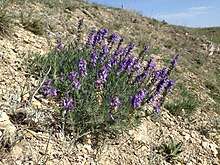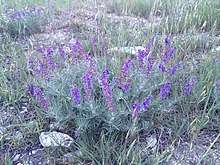Salvia jurisicii
Salvia jurisicii, commonly known as Jurisic sage and Yugoslavian cut leaf sage or locally as Ovche Pole sage, is a hardy herbaceous perennial endemic to the steppe-like Ovche Pole region in central North Macedonia. Together with other endemic species, Salvia jurisicii constitutes a key component of the “Macedonian steppe” ecotype[1]. Mainly due to agricultural activity, this species is considered critically endangered in its native habitat.
| Salvia jurisicii | |
|---|---|
 | |
| Scientific classification | |
| Kingdom: | Plantae |
| Clade: | Tracheophytes |
| Clade: | Angiosperms |
| Clade: | Eudicots |
| Clade: | Asterids |
| Order: | Lamiales |
| Family: | Lamiaceae |
| Genus: | Salvia |
| Species: | S. jurisicii |
| Binomial name | |
| Salvia jurisicii Kosanin | |
Description
Salvia jurisicii is a small compact plant, about 30cm tall and wide, with pinnate leaves that have linear segments. The olive-green leaves are much branched, with hairs on the back of the ribs and leaves giving the plant a frothy appearance. The small flowers are covered in hairs and grow in closely spaced whorls that are turned upside down. The flower colour ranges from white to violet.[2]

Habitat
Salvia jurisicii was first described by Koshanin, in 1923, from the Ovche Pole basin in central North Macedonia. Various climatic, geological and anthropogenic factors have contributed to the development of a characteristic xerothermic, steppe-like vegetation in this region – a so-called “Macedonian steppe”. The typical floristic associations for this eco-type, including its unique endemic and halophytic elements, have been described by Matevski et al[1]. With the hill Orlovo Brdo in the adjacent Negotino municipality in North Macedonia, Ovche Pole constitutes the total area of distribution for Salvia jurisicii – less then 300km2. In fact, up to 70% of the populations are found between the municipalities Sveti Nikole and Shtip.[3] Within this territory, populations of Salvia jurisicii have been registered in the vicinities of the villages Mustafino, Vrsakovo, and Delisinci.


Conservation
The construction of an irrigation canal in Ovche Pole during the 1970s contributed to the gradual expansion of farmland in this region. Previously covering most of Ovche Pole, the steppe vegetation as a result now occupies only a small fraction, on non-cultivated areas – “islands”, scattered across this territory. As a rule, Salvia jurisicii appears on a few non-disturbed such “islands” exclusively. Surrounding agricultural activity impedes the natural migration processes of this species, forming geographically isolated populations. Where the non-cultivated areas are arable, these populations are especially threatened by expanding farmland and land usurpation.
Another significant threat to this species stems from development projects (roads, power-lines, windmills, landfills, etc.) implemented across the Ovche Pole territory, typically in Salvia jurisicii habitats. The combination of permissive ecological surveying and poor implementation renders these projects their character as a pending threat to the future survival of this species. Other noteworthy threats include illegal plant collection, afforestation activities, and fires, which, as a traditional farming practice and due to the high aridity of Ovche Pole, are a continuing occurrence in this region. These various threats are especially problematic in Ovche Pole, where Salvia jurisicii and its floral community do not enjoy any sort of formal protection currently. What is more, little is known about the actual distribution of Salvia jurisicii in the Ovche Pole region or the extent to which past and present agricultural/developmental activities have affected it.
Seeing its very limited distribution, a 1998 work by Walter and Gillet[4] classifies this species as Rare (“R”) on the IUCN Red List of species according to the contemporary IUCN criteria. Salvia jurisicii is not yet assessed in line with the current IUCN criteria. However, according to relevant national lists and botanical experts, the applicable category for this species is Critically Endangered (“CR”).
Because of Salvia jurisicii’s rarity, as well as the unique floral compositions in which this species appears, key locations in the extended steppe-like region have either been protected or are considered for some form of protection. Thus, Orlovo Brdo currently enjoys the status of a Natural Monument in North Macedonia. In the Ovche Pole basin, the hill Bogoslovec is assessed as an Important Plant Area (IPA)[5] and the Ovche Pole basin itself as a Key Biodiversity Area (KBA)[6]. Ovche Pole is also home to the eastern imperial eagle (Aquila heliaca) and the Egyptian vulture (Neophron percnopterus), whose IUCN status as Vulnerable makes for categorizing this region as an Important Bird Area (IBA). For all these reasons, the Ovche Pole area is proposed as a Natura 2000 Site of Community Importance (SCI)[7].

Use
In relation to its phytochemical properties, Salvia jurisicii is assumed comparable to the culinary sage, Salvia officinalis.[8] This speculation is supported by Alimpich et al[9], whose phytochemical analysis of above-ground parts of Salvia jurisicii indicates that this species, especially the leaves, could be regarded as a potential source of natural antioxidants. While this study argues for the economic potential of Salvia jurisicii, with possible value for the cosmetic industry and medicine for example, this species has not yet been grown or harvested commercially for this purpose.
Apart from pharmaceutical, Salvia jurisicii also has an ornamental value. For example, Clebsch[2] argues that this species’ horticultural properties make it especially adequate for the rock garden – it is compact, tidy, as well as resistant to drought and winter cold. Clebsch also indicates that, in addition to the wild-type with purple flowers, there also is a white-flowering variety called “Alba”. As a garden plant, Salvia jurisicii is not particularly demanding; it can be grown from seed or from cuttings, its only needs being easily draining soil, weekly irrigation, and plenty of sunlight.

Notes
- Matevski, Vlado; Čarni, Andraž; Kostadinovski, Mitko; Košir, Petra; Šilc, Urban; Zelnik, Igor (2009-01-30). Flora in vegetacija makedonske stepe / Flora and Vegetation of the Macedonian Steppe / Flora i vegetacija na makedonskata stepa. ZRC SAZU, Založba ZRC. ISBN 978-961-254-549-9.
- Clebsch, Betsy; Barner, Carol D. (2003). The New Book of Salvias. Timber Press. p. 161. ISBN 978-0-88192-560-9.
- Мицевски, В., Матевски, В. & Сидеровски, К. (2010). Оцена на влијанието врз биолошката разновидност од интерконективен 400kV далекувод ТС Штип - македонско-српска граница. (Секторска Студија).
- Walter K. S., Gillett H. J. 1998: 1997 IUCN Red List of Threatened Plants. Compiled by the World Conservation Monitoring Centre. IUCN – The World Conservation Union, Gland, Switzerland and Cambridge, UK.
- Brajanoska, R., Hristovski, S. eds. (2015). Report on the status of protected areas in Bregalnica watershed. Final report of the project “Ecological Data Gap Analysis and Ecological Sensitivity Map Development for the Bregalnica River Watershed”, Book 4, Skopje.
- Melovski, L., Velevski, M., Matevski, V., Avukatov, V. & Sarov, A. (2012). Using important plant areas and important bird areas to identify Key Biodiversity Areas in the Republic of Macedonia. Journal of Threatened Taxa, Vol 4, pp 1-13.
- "Natura 2000 North Macedonia".
- Јовановска, Ј., Стефков, Ѓ. & Карапанџова, М. (2009). Фармакогностички интересни ендемични растенија во Република Македонија. Macedonian Pharmaceutical Bulletin, 55(1, 2), pp 41-55.
- Alimpic, A.Z. Duletic-Lausevic, S.N., Matevski, M.S., Marin, P.D. (2015). Antioxidant activity of Salvia jurisicii Kosanin ethanol extracts. Botanica Serbica, 39(1), pp53-58.